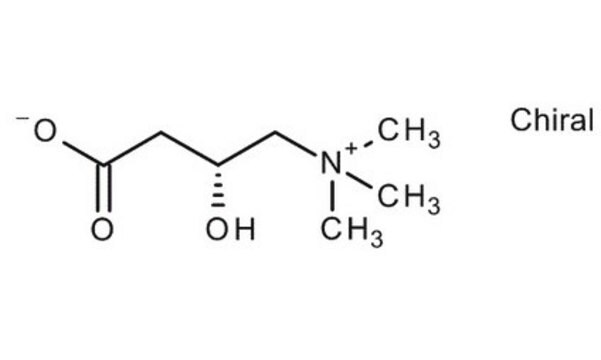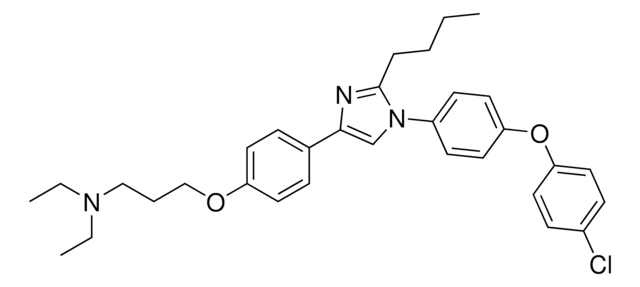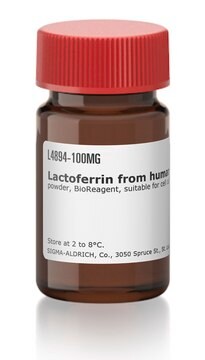E8780
Epiregulin from mouse
recombinant, expressed in E. coli, lyophilized powder, suitable for cell culture
Sinonimo/i:
EREG
Autenticatiper visualizzare i prezzi riservati alla tua organizzazione & contrattuali
About This Item
Numero MDL:
Codice UNSPSC:
12352200
Prodotti consigliati
Ricombinante
expressed in E. coli
Saggio
≥97% (SDS-PAGE)
Stato
lyophilized powder
PM
predicted mol wt ~5.5 kDa
tecniche
cell culture | mammalian: suitable
Impurezze
endotoxin, tested
N° accesso UniProt
Temperatura di conservazione
−20°C
Informazioni sul gene
mouse ... Ereg(13874)
Azioni biochim/fisiol
Binds and activates the tyrosine kinase ErbB family receptors (ErbB1-ErbB4). Inhibits the growth of several epithelial tumor cells and stimulates the growth of fibroblasts and other cell types. Its expression is upregulated in a number of carcinoma cell lines.
Stato fisico
Lyophilized from a 0.2 μm filtered solution in phosphate buffered saline containing 0.5 mg bovine serum albumin.
Nota sulla preparazione
Recombinant Mouse Epiregulin is produced from a DNA sequence encoding the mature mouse epiregulin protein sequence. The protein is expressed in E. coli.
Epiregulin is a member of EGF (epidermal growth factor) family. All members of the EGF family are synthesized as transmembrane precursors and converted to soluble forms by proteolytic cleavage. Epiregulin was originally purified from the mouse fibroblast-derived tumor cell line NIH3T3/T7. Mouse epiregulin cDNA encodes a transmembrane precursorof 162 amino acids with a mature soluble form consisting of residues 56-101. Epiregulin acts like other EGF family members by binding to and activating the tyrosine kinase ErbB family receptors (ErbB1-ErbB4). Epiregulin has a broad specificity, but this ligand seems to preferentially activate heterodimeric receptor complexes. Epiregulin inhibits the growth of several epithelial tumor cells and stimulates the growth of fibroblasts and other types of cells. Its expression is upregulated in a number of carcinoma cell lines. Epiregulin is also an autocrine growth factor in human epidermal keratinocytes, and involved in the early stages of pregnancy, regulating the attachment of the blastocyst to the uterine epithelium during the implantation process.
Epiregulin is a member of EGF (epidermal growth factor) family. All members of the EGF family are synthesized as transmembrane precursors and converted to soluble forms by proteolytic cleavage. Epiregulin was originally purified from the mouse fibroblast-derived tumor cell line NIH3T3/T7. Mouse epiregulin cDNA encodes a transmembrane precursorof 162 amino acids with a mature soluble form consisting of residues 56-101. Epiregulin acts like other EGF family members by binding to and activating the tyrosine kinase ErbB family receptors (ErbB1-ErbB4). Epiregulin has a broad specificity, but this ligand seems to preferentially activate heterodimeric receptor complexes. Epiregulin inhibits the growth of several epithelial tumor cells and stimulates the growth of fibroblasts and other types of cells. Its expression is upregulated in a number of carcinoma cell lines. Epiregulin is also an autocrine growth factor in human epidermal keratinocytes, and involved in the early stages of pregnancy, regulating the attachment of the blastocyst to the uterine epithelium during the implantation process.
Risultati analitici
The biological activity is measured by its ability to stimulate the 3H-thymidine incorporation in a mouse fibroblast cell line, Balb/3T3.
Codice della classe di stoccaggio
11 - Combustible Solids
Classe di pericolosità dell'acqua (WGK)
WGK 3
Punto d’infiammabilità (°F)
Not applicable
Punto d’infiammabilità (°C)
Not applicable
Dispositivi di protezione individuale
Eyeshields, Gloves, type N95 (US)
Scegli una delle versioni più recenti:
Possiedi già questo prodotto?
I documenti relativi ai prodotti acquistati recentemente sono disponibili nell’Archivio dei documenti.
K Hashimoto
Journal of dermatological science, 24 Suppl 1, S46-S50 (2001-01-04)
Various kinds of growth factors are involved in the regulation of human keratinocyte function. Among them, the epidermal growth factor (EGF) family and the transforming growth factor-beta (TGF-beta) family play central roles, providing dual-mode regulation of keratinocyte growth through the
H Toyoda et al.
FEBS letters, 377(3), 403-407 (1995-12-27)
A cDNA clone encoding a novel epidermal growth factor (EGF)-related growth regulator, epiregulin, was isolated from a cDNA library prepared from a mouse fibroblast-derived tumor cell line, NIH3T3/clone T7. The predicted amino acid sequence revealed that the purified epiregulin peptide
Jian-Bo Fan et al.
Molecular and cellular biochemistry, 398(1-2), 105-113 (2014-09-17)
Epidermal growth factor (EGF) receptor (EGFR) emerges as an essential molecule for the regulating of osteoblast cellular functions. In the current study, we explored the effect of epiregulin, a new EGFR ligand, on osteoblast functions in vitro, and studied the
K P Karey et al.
Cancer research, 48(14), 4083-4092 (1988-07-15)
A completely serum-free assay method has been used to compare the mitogenic activities of polypeptide growth factors and estrogens with MCF-7 and T47D human breast cancer cells in culture. The lines were maintained in a viable, slowly dividing condition in
Teresa Elo et al.
Endocrine-related cancer, 21(4), 677-690 (2014-06-19)
Estrogens contribute to the development and growth of the prostate and are implicated in prostate tumorigenesis. In their target tissues, estrogens mediate their effects via estrogen receptor α (ERα (ESR1)) and β (ERβ (ESR2)). Hyperplasia and decreased differentiation of epithelial
Il team dei nostri ricercatori vanta grande esperienza in tutte le aree della ricerca quali Life Science, scienza dei materiali, sintesi chimica, cromatografia, discipline analitiche, ecc..
Contatta l'Assistenza Tecnica.





